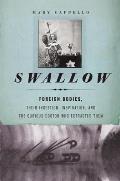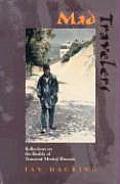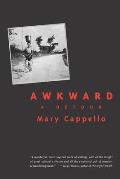
With the appearance of Amanda Schaffer's beautiful essay on
Swallow in the
New York Times yesterday, "Swallowed Objects That Went Straight into History," and in the aftermath of two wonderful readings that I did last week on the West Coast (one at the alternate universe that is the magnificent
Velaslavasay Panorama, and another at the wonderfully accommodating
Book Soup, both in LA), as well as an interview for
CBC/Vancouver, I find myself — you probably think I'm going to say "exhausted," but, no — I find myself stimulated by questions that people are asking me about Jackson and his collection.
I was going to blog today about the way in which new, unexpected friendships are formed when one writes biographically, but it seemed more timely just this minute to share some of the questions — unsolved mysteries, really — that people are asking and to pose just a glimmer of a response.
Three questions in particular have emerged in the past few days: Why do people swallow nonnutritive things? What is the strangest item in Chevalier Jackson's collection? And was Chevalier Jackson autistic or could he be understood as being on an autism/Asperger's spectrum?
I think that I answer all three of these questions in my book, and from a variety of angles, though I don't raise a question of whether Jackson was autistic explicitly. Still, I'll try to offer sketchily provocative answers here, just to give a sense of how I think about these things.
 Personally, I'm less interested in answers than in discovering new ways to think about what I thought I knew. For me, that's what's exciting about poetic investigation, or scientific investigation at its best. Trying to think about why people swallow nonnutritive things requires entry into a range of realms of experience, culture, and psychology. In my research, for example, I discovered that a number of women in the 1920s U.S. ingested hardware in great number (I discuss three very particular cases of this in my book — cases in which hundreds of items were found in the same person's stomach). I ask that we think about these cases in a socio-cultural way: I mean, is there anything people do that isn't somehow or other culturally instigated? That isn't in some way suggested to them by the very milieu in which they live? The time and place? And could we think, then, of all human behavior — even that which we find most strange, reprehensible, or incomprehensible, as being drawn from a cultural repertoire? With questions like these in mind, I try to understand swallowing acts like those of the women in the 1920s in terms of their historical context. (I draw on Ian Hacking's work in thinking about this — his work on what he calls "transient mental illness," the idea that some mental illnesses (so-called) appear at particular times and places in the history of humankind and then disappear.) The hardware swallowers, it seems to me, were responding to a demand of the age in which they lived — the age of Taylorism, the machine age, the age in which Charlie Chaplin is pictured swallowing nuts and bolts in Modern Times, an age in which people were required to be more machine-like. But of course no single ground, basis, or motivation does justice to people's ingestion of nonnutritive things, and I don't mean to explain away the problem with one attributable source.
Personally, I'm less interested in answers than in discovering new ways to think about what I thought I knew. For me, that's what's exciting about poetic investigation, or scientific investigation at its best. Trying to think about why people swallow nonnutritive things requires entry into a range of realms of experience, culture, and psychology. In my research, for example, I discovered that a number of women in the 1920s U.S. ingested hardware in great number (I discuss three very particular cases of this in my book — cases in which hundreds of items were found in the same person's stomach). I ask that we think about these cases in a socio-cultural way: I mean, is there anything people do that isn't somehow or other culturally instigated? That isn't in some way suggested to them by the very milieu in which they live? The time and place? And could we think, then, of all human behavior — even that which we find most strange, reprehensible, or incomprehensible, as being drawn from a cultural repertoire? With questions like these in mind, I try to understand swallowing acts like those of the women in the 1920s in terms of their historical context. (I draw on Ian Hacking's work in thinking about this — his work on what he calls "transient mental illness," the idea that some mental illnesses (so-called) appear at particular times and places in the history of humankind and then disappear.) The hardware swallowers, it seems to me, were responding to a demand of the age in which they lived — the age of Taylorism, the machine age, the age in which Charlie Chaplin is pictured swallowing nuts and bolts in Modern Times, an age in which people were required to be more machine-like. But of course no single ground, basis, or motivation does justice to people's ingestion of nonnutritive things, and I don't mean to explain away the problem with one attributable source.
Why do people voluntarily swallow objects? For this, we'd also have to consider a person's individual psychic disposition, their relationship to pleasure and distress in particular. And we'd have to put "volition" (or "voluntarily") in quotation marks — especially if we believe in something like a human unconscious. But it doesn't end there because the human mouth (unlike other bodily orifices) is the site of knowledge, language, breath, appetite, desire, and aggression, to name a few. Swallowing "things" can serve the purpose of self-soothing; as a stopgap to speaking; as a testing of the limits of one's capaciousness. Not reducible to hunger in the literal sense, it can represent a form of emotional hunger. Typically, the act is associated with an array of mental disorders, so-called, but cannot be easily pinned to ONE disorder, and this is partly why such swallowing feats confound psychologists.
After Swallow appeared, I discovered that a gastroenterologist in my own neighborhood in Providence, RI, had just published an article about the rather large number of items he had retrieved from people's stomachs in the recent past at Rhode Island hospital — items that had been purposely swallowed. In his article, Dr. Steven Moss notes that such acts are linked to mood disorders, anxiety disorders, schizophrenia, and other DSM-IV categories, thus making it difficult to treat or control. It is also found in autistic children, and in people who are identified as being developmentally disabled. It's found in pregnant women, too. It's sometimes a form of self-injury, but not always; it's often a form of self-pleasuring; it might seem to suggest a form of suicide, but it's often not. Indeed, as I note in Swallow, there are as many words for types of pica (the DSM-IV term for the swallowing of nonnutritive things) as there are different objects in the world.
When I try to answer the question, why do people voluntarily swallow things, I also find myself wanting to transform the question. I begin to wonder if asking what motivates intentional swallowers is the wrong question, and if the better question might be something like what makes such an act necessary or possible? What is the act continuous with or part and parcel of? Because it's really never explicable in a simple cause-and-effect way; nor can it be supplied with a reducible ground: it's more like a habit, and a way, and perhaps a route — but to what? A form of expression, of what?
It's also curious to me that people act aghast when they hear that some of their fellow humans swallow objects, but also take great pleasure in watching people test their capacity to eat beyond what's humanly possible, and have enjoyed watching people put swords down their throats for centuries. (I try to understand this in Swallow).
Over and against this, I'm moved to consider an even more counter-intuitive question: why do we find one kind of insertion of the material world into the mouth psychopathological and another kind of insertion so unquestionable as to be considered natural, simply a matter of course? I mean, why does no one ask what motivates doctors in the history of medicine to insert metal tubes into people's throats? (Swordswallowers, it turns out, inspired the first endoscopists.)
What is the strangest thing in the Chevalier Jackson collection? What was the strangest thing a person swallowed?
Why do I want to resist that question? I could say the padlock, the belt buckles, or the wrist watch are strangest. Or, I could consider how that question is a question about the interpreter of the collection — that how we answer it tells us something about ourselves — or something about the nature of the "strange." I like to say that the buttons are most strange precisely because they are most commonplace. Because their presence in the collection suggests that an entirely ordinary and banal thing threatened a human life. That, to me, makes the buttons the most strange. But then I also am compelled by wondering what kind of knowledge any of us, by way of questions, wants the foreign body exhibit to yield. What do I think I want to know and what can I come to know through the collection?
Again, in some ways, though not always or entirely, I'm more interested in the question the cabinet animates than the answers that it yields.
 A question that appeared on Michelle Dawson's twitter page and thereafter on a blog following the article that appeared in today's New York Times is, was Chevalier Jackson autistic? This is a fascinating question to me. I believe the question emerged because of some of the details of Jackson's personality as they were presented in the article: that he was an obsessive collector, a mechanical genius, and a seemingly asocial person. I'm sure that someone with greater expertise than I could answer this question, but I'll share my sense of an answer to it based on my limited knowledge. What I know about autism is partly gleaned from my experience with my nephew on my partner's side of the family who is severely autistic and has been treated since about the time he was 2 years old with Lovaas therapy (he is soon to turn 13); the work I've read about and by Temple Grandin; numerous other books and articles on the subject, with a favorite being Paul Collins' memoir about his son, Not Even Wrong: Adventures in Autism. I also wrote a little about my nephew in Awkward — in part, because I found myself wondering if in order to feel awkward, one had to have a particular relationship to language, and therefore to self-consciousness, that my severely autistic nephew did not appear to have. I go to great lengths in Swallow to understand Chevalier Jackson's complex psychology — especially in light of the story he tells of his life in his 1938 bestselling autobiography, The Life of Chevalier Jackson. I read his asociality not as something that he experienced from a very young age, but something that was a response to years of bullying and torment by his childhood peers. He admits to not having much faith in other people, and finds it hard to trust other people — this, at the same time that he was student to a great many mentors whom he loved and revered. I find evidence in the archive of his having maintained lasting, intimate friendships (as opposed to popular understandings of him as phobically aloof). He was obsessive — maniacally so — but I don't read this in a pathological way. He also enjoyed and pursued a range of interests (at the same time that he maintained a single-mindedness) that included painting, writing, and instrument design. Perhaps after reading the book, students of autism and its spectrum can shed light on whether they think Chevalier Jackson exemplifies yet another great contributor to human knowledge and human life who could be understood as an autist.
A question that appeared on Michelle Dawson's twitter page and thereafter on a blog following the article that appeared in today's New York Times is, was Chevalier Jackson autistic? This is a fascinating question to me. I believe the question emerged because of some of the details of Jackson's personality as they were presented in the article: that he was an obsessive collector, a mechanical genius, and a seemingly asocial person. I'm sure that someone with greater expertise than I could answer this question, but I'll share my sense of an answer to it based on my limited knowledge. What I know about autism is partly gleaned from my experience with my nephew on my partner's side of the family who is severely autistic and has been treated since about the time he was 2 years old with Lovaas therapy (he is soon to turn 13); the work I've read about and by Temple Grandin; numerous other books and articles on the subject, with a favorite being Paul Collins' memoir about his son, Not Even Wrong: Adventures in Autism. I also wrote a little about my nephew in Awkward — in part, because I found myself wondering if in order to feel awkward, one had to have a particular relationship to language, and therefore to self-consciousness, that my severely autistic nephew did not appear to have. I go to great lengths in Swallow to understand Chevalier Jackson's complex psychology — especially in light of the story he tells of his life in his 1938 bestselling autobiography, The Life of Chevalier Jackson. I read his asociality not as something that he experienced from a very young age, but something that was a response to years of bullying and torment by his childhood peers. He admits to not having much faith in other people, and finds it hard to trust other people — this, at the same time that he was student to a great many mentors whom he loved and revered. I find evidence in the archive of his having maintained lasting, intimate friendships (as opposed to popular understandings of him as phobically aloof). He was obsessive — maniacally so — but I don't read this in a pathological way. He also enjoyed and pursued a range of interests (at the same time that he maintained a single-mindedness) that included painting, writing, and instrument design. Perhaps after reading the book, students of autism and its spectrum can shed light on whether they think Chevalier Jackson exemplifies yet another great contributor to human knowledge and human life who could be understood as an autist.
Other unsolved mysteries persist: I've wondered if the descendents of the African-American boy who did not survive the extraction of the Perfect Attendance Pin in Jackson's collection maintain a family memory of this tragedy? I wonder what happened to another boy (a baby) who was forced to swallow over thirty items by a person who had been left to watch him? I know that Chevalier Jackson saved his life and that he lived well beyond the extraction because his family sent Jackson pictures of him as he grew. But I don't know anything more than that. I wonder how the babysitter spent her own last days. These are some of the questions I wasn't able to answer in my book, though as a friend of mine suggests, perhaps someone will write a novel based on these.